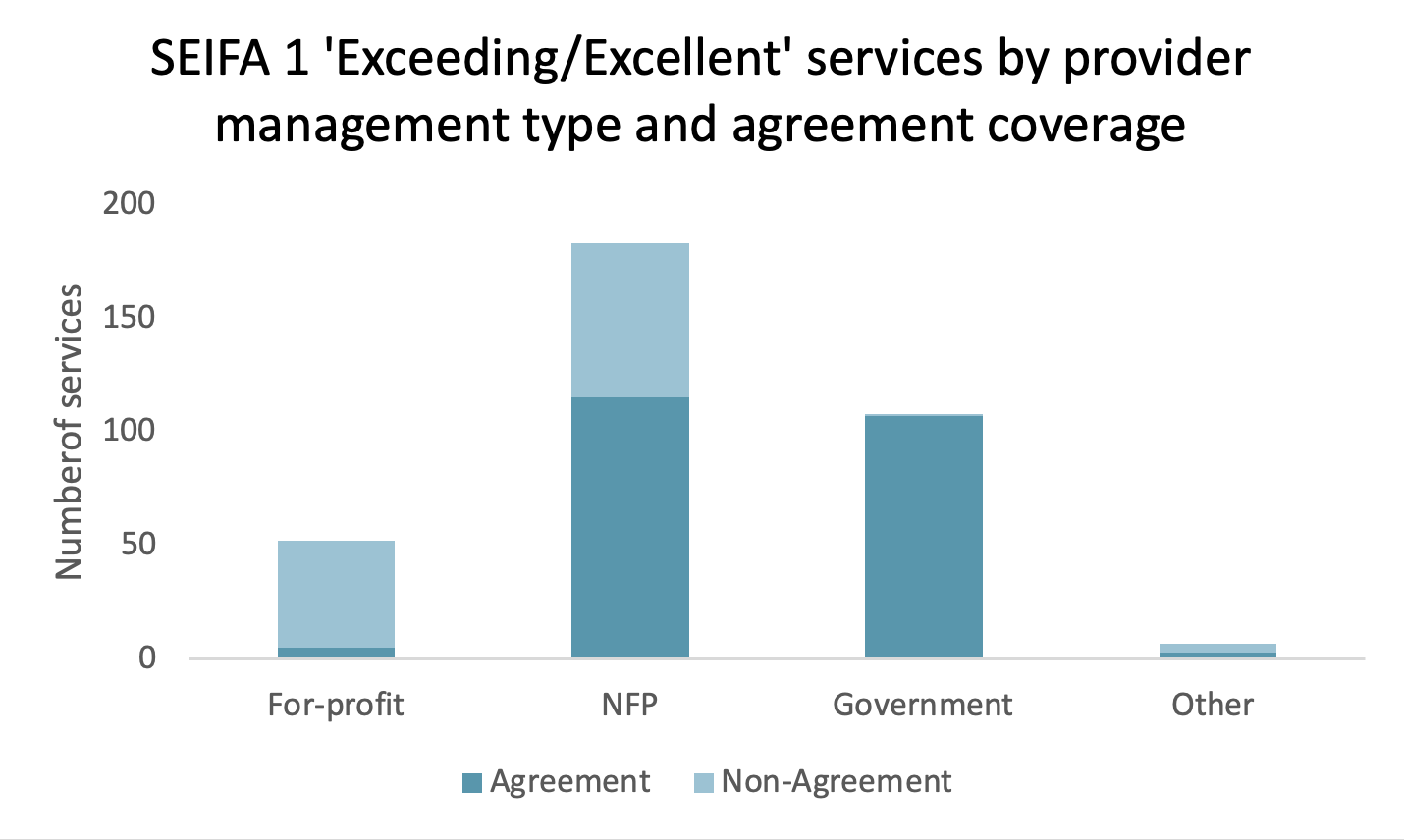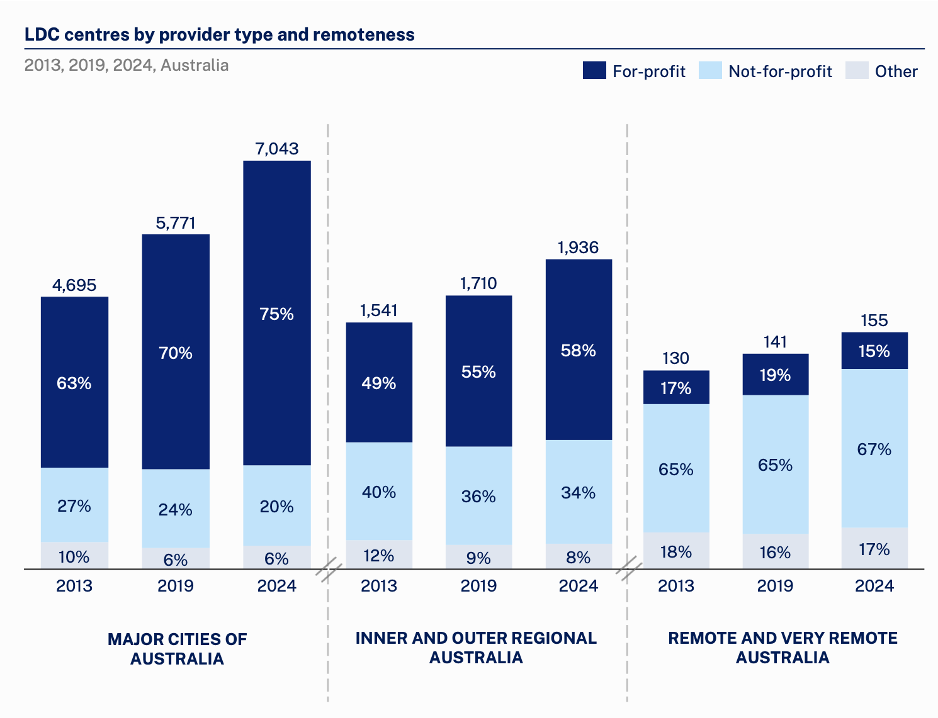The Hidden Lever:
How pay and conditions support child outcomes in low SES early childhood education and care services
Delivering universal access to early childhood education and care (ECEC) will benefit families, children and society. However, the value of universal access will not be realised without prioritising service quality.
The Front Project analysed the relationship between high-quality ECEC services and staffing conditions, particularly in low SES communities where we know children have the most to gain.
We found an association between better workforce conditions and high-quality service delivery, which we know also has a positive impact on children.
Explore:
Several questions guided our research:
- What are the workforce and workplace profiles of SEIFA level 1 Excellent and Exceeding services?
- What are the specific conditions that staff are receiving and may influence quality outcomes for children?
- How could this information help guide policy?
Socio-Economic Indexes for Areas (SEIFA) ranks areas in Australia according to relative socio-economic advantage and disadvantage. SEIFA 1 services – those located in areas ranked as having high levels of socio-economic disadvantage - were examined.
Data was gathered from ACECQA’s NQS Q2 2024 list of approved services, and filtered to SEIFA 1 Long Daycare & Preschool services with a rating of Exceeding or Excellent (350 services). From here, a sample was collected of 45 centres with EBAs, ranging across all jurisdictions and provider management types.
- In SEIFA 1 areas not-for-profits and Department/local government services make up 68% of services and 83% of all ‘Exceeding/Excellent’ services.
- 66% of SEIFA 1 Exceeding/Excellent services analysed in this sample are covered by an Enterprise Bargaining Agreement (EBA)*. This is much higher than the overall sector at 29.7%, suggesting a link between industrial conditions and service quality (ACECQA Q2 2024).
- Centres operating under EBAs consistently offer more generous staffing conditions than Award-reliant services. Multi-employer agreements tend to be high-quality due to the bargaining power behind them.
- Preschools and kindergartens (PSKs) generally offer better workforce conditions than long daycare centres (LDCs), due to their distinct operational model, funding structure, and history of enterprise/collective bargaining.
*Note this analysis was undertaken prior to the implementation of the Wage Justice Bill 2024.

For-profit providers make up 42% of the SEIFA 1 segment with 15% of SEIFA 1 ‘Exceeding/Excellent’ services.
Not-for-profit providers make up 37% of the SEIFA 1 market, but have a much higher proportion of ‘Exceeding/Excellent’ services at 52%.
Services that are managed by government schools, state/territory education departments or local councils make up 31% of the SEIFA 1 ‘Exceeding/Excellent’ services.
This demonstrates the value of not-for-profit and Department/local government providers, who are more likely to deliver outstanding services to children in low SES areas.

In SEIFA 1, 63% of ‘Exceeding/Excellent’ NFP providers are covered by an EBA, whereas only 10% of for-profit providers are.
100% of ‘Exceeding/Excellent’ services that are managed by government schools, state/territory education departments or local councils are covered by an EBA.
*This dataset does not include services recently signed to the Wage Justice Bill
This reveals that in SEIFA 1 areas:
- Where there is high quality, there are higher proportions of coverage by enterprise agreements
- Where there is lower quality there is lower coverage of enterprise agreements.
High quality and better conditions travel together - as do lower quality and poorer conditions.

In non-urban areas 79% of ECEC providers are small providers, with only one service.
For-profit services make up the majority of services across Australia. Nationally, 75% of Long Day Care (LDC) centres are for-profit.
However, the for-profit domination of the market is not the case in remote areas, with not-for-profit providers making up the majority of services.
This is primarily due to the unprofitability for for-profit providers operating a service in regional areas.
*Image source: Mandala Report - Paving the Path
As of March 2024, there are a number of Commonwealth-funded initiatives that support regional and remote ECEC workforce, including:
- Tertiary Access Payment – one-off relocation payment for regional students
- Local Jobs Program - upskilling, reskilling and establishing employment pathways for job seekers in 51 regions
- Financial assistance for very remote teachers – waives and reduces HELP debt
- Limited Supply Grant - fund for new providers to open in areas with limited access
- ECEC 15% Worker Retention Payment - a backdated grant for providers to support a 15% pay increase over two years.
- Launch into Work Program - for businesses who have entry-level job opportunities and are willing to trial a new way of recruiting.
- Practicum Payment for Professional Development Support - a subsidy to cover one day of training backfill
- Free TAFE - no cost for Certificate III in Early Childhood Education and Care qualification
What Can Government Do?
These findings provide insight into what the workforce need and what employers -including governments - can do to drive quality.
At a state and territory level, governments can have a role in supporting workforce conditions for quality in preschool, as a funder and often as an employer.
At Commonwealth level, government can leverage $14b in Child Care Subsidy to drive the conditions that we know drive quality and outcomes for children, and put providers on the hook for delivering this.
Furthermore, this research has been undertaken with publicly available data and information shared by individuals. Government has access to critical data sets that can be leveraged to seek out instances of both protective and risk factors for quality for children and families.
